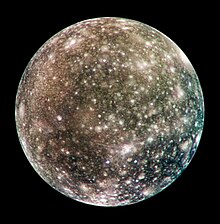കാലിസ്റ്റോ
വ്യാഴത്തിന്റെ രണ്ടാമത്തെ വലിയ ഉപഗ്രഹവും സൗരയൂഥത്തിലെ മൂന്നാമത്തെ വലിയ ഉപഗ്രഹവുമാണ് കാലിസ്റ്റോ. കാലിസ്റ്റോയുടെ വ്യാസം ബുധഗ്രഹത്തിനേക്കാൾ ഏതാനും കിലോമീറ്ററുകൾ മാത്രം കുറവാണ് . സൗരയൂഥത്തിൽ വ്യാസത്തിന്റെ തന്നെ ഗാനിമേടും ശനിയുടെ ടൈറ്റാനും മാത്രമാണ് കാലിസ്റ്റോയെക്കാൾ വലിപ്പമുള്ള ഉപഗ്രഹങ്ങൾ . വ്യാഴത്തിൽ നിന്നും ഏറ്റവും അകലെയുള്ള ഗലീലിയൻ ഉപഗ്രഹം ആയതിനാൽ തന്നെ ഭൗമശാസ്ത്രപരമായി അത്ര സജീവ അവസ്ഥയിൽ അല്ല കാലിസ്റ്റോ . സിലിക്ക പാറകളും ജല ഐസുമാണ് കാലിസ്റ്റോയുടെ പ്രധാന ഘടകങ്ങൾ . സൗരയൂഥത്തിലെ ഏറ്റവും ഗർത്തങ്ങൾ നിറഞ്ഞ പ്രതലമാണ് കാലിസ്റ്റോയുടേത് . കാലിസ്റ്റോക്ക് ചുറ്റും കാർബൺ ഡൈ ഓക്സിഡിന്റെ നേർത്ത ഒരന്തരീക്ഷം ഉണ്ട് . യൂറോപ്പയെയും ,ഗാനമേടിനെയും പോലെ കാലിസ്റ്റോക്കും പ്രതലത്തിനുള്ളിൽ ഒരു വലിയ ദ്രവലവണ സമുദ്രം ഉണ്ട് എന്നത് പര്യവേക്ഷണ പേടകങ്ങളുടെ പഠനത്തിൽ നിന്നും വ്യക്തമായിട്ടുണ്ട്
 Callisto's anti-Jovian hemisphere imaged in 2001 by NASA's Galileo spacecraft. It shows a heavily cratered terrain. The large impact structure Asgard is on the limb at upper right. The prominent rayed crater below and just right of center is Bran. | |||||||||
| കണ്ടെത്തൽ | |||||||||
|---|---|---|---|---|---|---|---|---|---|
| കണ്ടെത്തിയത് | Galileo Galilei | ||||||||
| കണ്ടെത്തിയ തിയതി | January 7, 1610[1] | ||||||||
| വിശേഷണങ്ങൾ | |||||||||
| Jupiter IV | |||||||||
| Adjectives | Callistoan, Callistonian | ||||||||
| ഭ്രമണപഥത്തിന്റെ സവിശേഷതകൾ | |||||||||
| Periapsis | 1869000 കി.മീ[a] | ||||||||
| Apoapsis | 1897000 കി.മീ[b] | ||||||||
| 1 882 700 km[2] | |||||||||
| എക്സൻട്രിസിറ്റി | 0.0074[2] | ||||||||
| 16.6890184 d[2] | |||||||||
Average പരിക്രമണവേഗം | 8.204 km/s | ||||||||
| ചെരിവ് | 2.017° (to the ecliptic) 0.192° (to local Laplace planes)[2] | ||||||||
| ഉപഗ്രഹങ്ങൾ | Jupiter | ||||||||
| ഭൗതിക സവിശേഷതകൾ | |||||||||
ശരാശരി ആരം | 2410.3±1.5 കി.മീ (0.378 Earths)[3] | ||||||||
| 7.30×107 km2 (0.143 Earths)[c] | |||||||||
| വ്യാപ്തം | 5.9×1010 km3 (0.0541 Earths)[d] | ||||||||
| പിണ്ഡം | (1.075938±0.000137)×1023 കി.g (0.018 Earths)[3] | ||||||||
ശരാശരി സാന്ദ്രത | 1.8344±0.0034 g/cm3[3] | ||||||||
| 1.235 m/s2 (0.126 g)[e] | |||||||||
| 0.359±0.005[4] (estimate) | |||||||||
| 2.440 km/s[f] | |||||||||
| synchronous[3] | |||||||||
| zero[3] | |||||||||
| അൽബിഡോ | 0.22 (geometric)[5] | ||||||||
| |||||||||
| 5.65 (opposition)[6] | |||||||||
| അന്തരീക്ഷം | |||||||||
പ്രതലത്തിലെ മർദ്ദം | 7.5 picobar[7] (7.5×10−10 kPa, 7.4019×10−12 atm) | ||||||||
| ഘടന (വ്യാപ്തമനുസരിച്ച്) | ≈ 4×108 molecules/cm3 carbon dioxide;[7] up to 2×1010 molecules/cm3 molecular oxygen(O2)[8] | ||||||||
കുറിപ്പുകൾ
തിരുത്തുക- ↑ Periapsis is derived from the semimajor axis (a) and eccentricity (e): .
- ↑ Apoapsis is derived from the semimajor axis (a) and eccentricity (e): .
- ↑ Surface area derived from the radius (r): .
- ↑ Volume derived from the radius (r): .
- ↑ Surface gravity derived from the mass (m), the gravitational constant (G) and the radius (r): .
- ↑ Escape velocity derived from the mass (m), the gravitational constant (G) and the radius (r): .
- ↑ ഉദ്ധരിച്ചതിൽ പിഴവ്: അസാധുവായ
<ref>ടാഗ്;Galileiഎന്ന പേരിലെ അവലംബങ്ങൾക്ക് എഴുത്തൊന്നും നൽകിയിട്ടില്ല. - ↑ 2.0 2.1 2.2 2.3 ഉദ്ധരിച്ചതിൽ പിഴവ്: അസാധുവായ
<ref>ടാഗ്;orbitഎന്ന പേരിലെ അവലംബങ്ങൾക്ക് എഴുത്തൊന്നും നൽകിയിട്ടില്ല. - ↑ 3.0 3.1 3.2 3.3 3.4 ഉദ്ധരിച്ചതിൽ പിഴവ്: അസാധുവായ
<ref>ടാഗ്;Anderson 2001എന്ന പേരിലെ അവലംബങ്ങൾക്ക് എഴുത്തൊന്നും നൽകിയിട്ടില്ല. - ↑ Showman, A. P.; Malhotra, R. (1999-10-01). "The Galilean Satellites". Science. 286 (5437): 77–84. doi:10.1126/science.286.5437.77. PMID 10506564.
- ↑ 5.0 5.1 ഉദ്ധരിച്ചതിൽ പിഴവ്: അസാധുവായ
<ref>ടാഗ്;Moore2004എന്ന പേരിലെ അവലംബങ്ങൾക്ക് എഴുത്തൊന്നും നൽകിയിട്ടില്ല. - ↑ "Classic Satellites of the Solar System". Observatorio ARVAL. Archived from the original on 2013-10-22. Retrieved 2007-07-13.
- ↑ 7.0 7.1 ഉദ്ധരിച്ചതിൽ പിഴവ്: അസാധുവായ
<ref>ടാഗ്;Carlson 1999എന്ന പേരിലെ അവലംബങ്ങൾക്ക് എഴുത്തൊന്നും നൽകിയിട്ടില്ല. - ↑ ഉദ്ധരിച്ചതിൽ പിഴവ്: അസാധുവായ
<ref>ടാഗ്;Liang 2005എന്ന പേരിലെ അവലംബങ്ങൾക്ക് എഴുത്തൊന്നും നൽകിയിട്ടില്ല.